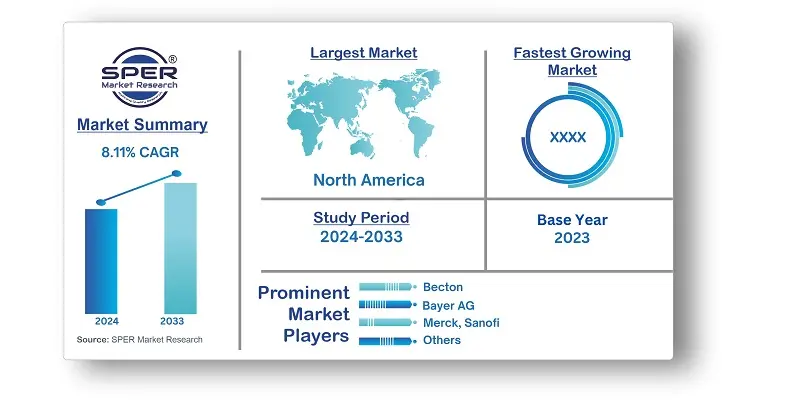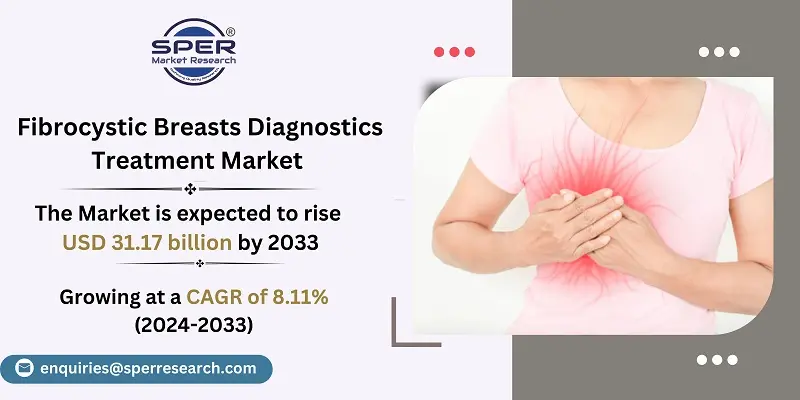
Fibrocystic Breasts Diagnostics Treatment Market Growth, Size, Trends, Share and Future Outlook
Fibrocystic Breasts Diagnostics Treatment Market Size- By Type, By End User- Regional Outlook, Competitive Strategies and Segment Forecast to 2033
| Published: May-2024 | Report ID: HLCA2458 | Pages: 1 - 211 | Formats*: |
| Category : Healthcare | |||
- September 2023: Boston Scientific will purchase Relievant, a manufacturer of chronic back pain therapy, in September 2023. Boston Scientific (BSX.N), a manufacturer of medical devices, agreed to pay $850 million up front to acquire Relievant Medsystems, a private medical technology business, in order to obtain access to an FDA-approved treatment for chronic pain.
- March 2023: Argon Medical will launch the Traveler Portal Vein Access Series in March 2023. By enhancing component durability and visualization, TRAVELER aims to mitigate certain typical issues encountered during Transjugular Intrahepatic Portosystemic Shunt (TIPS) surgeries.


| Report Metric | Details |
| Market size available for years | 2020-2033 |
| Base year considered | 2023 |
| Forecast period | 2024-2033 |
| Segments covered | By Types, By End Users |
| Regions covered | North America, Asia-Pacific, Latin America, Middle East & Africa and Europe |
| Companies Covered | Argon Medical Devices, Becton,Dickson and Company, Bayer AG, Boston Scientific Corp, Devicor Medical Products Inc., Johnson & Johnson Pvt. Ltd., Merck, Sanofi, Sun Pharmaceutical Industries, Teva Pharmaceutical Industries Ltd. |
- Healthcare Providers
- Women’s Health Organizations
- Medical Device Manufacturers
- Pharmaceutical Companies
- Research Institutions
- Health Insurance Companies
- Regulatory Agencies
- Diagnostic Laboratories
- Women’s Health Clinics
| By Type: |
|
| By End-Users: |
|
| By Region: |
|
- Global Fibrocystic Breasts Diagnostics Treatment Market Size (FY’2024-FY’2033)
- Overview of Global Fibrocystic Breasts Diagnostics Treatment Market
- Segmentation of Global Fibrocystic Breasts Diagnostics Treatment Market By Type (Diagnosis, Mammogram, Breast Biopsy, Treatment, Medications, Acetaminophen. Non-steroidal anti-inflammatory Drugs, Fine-Needle Aspiration, Surgical Excision, Oral Contraceptive)
- Segmentation of Global Fibrocystic Breasts Diagnostics Treatment Market By End Users (Hospitals, Clinics, Diagnostic Centers, Speciality Clinics and Rehab Centers, Research Institutes, Others.)
- Statistical Snap of Global Fibrocystic Breasts Diagnostics Treatment Market
- Expansion Analysis of Global Fibrocystic Breasts Diagnostics Treatment Market
- Problems and Obstacles in Global Fibrocystic Breasts Diagnostics Treatment Market
- Competitive Landscape in the Global Fibrocystic Breasts Diagnostics Treatment Market
- Impact of COVID-19 and Demonetization on Global Fibrocystic Breasts Diagnostics Treatment Market
- Details on Current Investment in Global Fibrocystic Breasts Diagnostics Treatment Market
- Competitive Analysis of Global Fibrocystic Breasts Diagnostics Treatment Market
- Prominent Players in the Global Fibrocystic Breasts Diagnostics Treatment Market
- SWOT Analysis of Global Fibrocystic Breasts Diagnostics Treatment Market
- Global Fibrocystic Breasts Diagnostics Treatment Market Future Outlook and Projections (FY’2023-FY’2033)
- Recommendations from Analyst
1.1. Scope of the report1.2. Market segment analysis
2.1. Research data source2.1.1. Secondary Data2.1.2. Primary Data2.1.3. SPER’s internal database2.1.4. Premium insight from KOL’s2.2. Market size estimation2.2.1. Top-down and Bottom-up approach2.3. Data triangulation
4.1. Driver, Restraint, Opportunity and Challenges analysis4.1.1. Drivers4.1.2. Restraints4.1.3. Opportunities4.1.4. Challenges4.2. COVID-19 Impacts of the Global Fibrocystic Breasts Diagnostics Treatment Market.
5.1. SWOT Analysis5.1.1. Strengths5.1.2. Weaknesses5.1.3. Opportunities5.1.4. Threats5.2. PESTEL Analysis5.2.1. Political Landscape5.2.2. Economic Landscape5.2.3. Social Landscape5.2.4. Technological Landscape5.2.5. Environmental Landscape5.2.6. Legal Landscape5.3. PORTER’s Five Forces5.3.1. Bargaining power of suppliers5.3.2. Bargaining power of buyers5.3.3. Threat of Substitute5.3.4. Threat of new entrant5.3.5. Competitive rivalry5.4. Heat Map Analysis
6.1. Global Fibrocystic Breasts Diagnostics Treatment Market Manufacturing Base Distribution, Sales Area, Product Type6.2. Mergers & Acquisitions, Partnerships, Product Launch, and Collaboration in Global Fibrocystic Breasts Diagnostics Treatment Market
7.1. Global Fibrocystic Breasts Diagnostics Treatment Market Size Share and Forecast, By Type, 2020-20267.2. Global Fibrocystic Breasts Diagnostics Treatment Market Size Share and Forecast, By Type, 2027-20337.3. Diagnosis7.4. Mammogram7.5. Breast Biopsy7.6. Treatment7.7. Medications7.8. Acetaminophen7.9. Non-steroidal Inflammatory Drugs7.10. Fine-needle Aspirations7.11. Surgical Excision
7.12. Oral Contraceptives
8.1. Global Fibrocystic Breasts Diagnostics Treatment Market Size Share and Forecast, By End Users, 2020-20268.2. Global Fibrocystic Breasts Diagnostics Treatment Market Size Share and Forecast, By End Users, 2027-20338.3. Hospitals8.4. Clinics8.5. Diagnostic Centers8.6. Speciality Clinics and Rehab Centers8.7. Research Institutes8.8. Others
9.1. Global Fibrocystic Breasts Diagnostics Treatment Market Size and Market Share
10.1. Global Fibrocystic Breasts Diagnostics Treatment Market Size and Market Share By Region (2020-2026)10.2. Global Fibrocystic Breasts Diagnostics Treatment Market Size and Market Share By Region (2027-2033)10.3. Asia-Pacific10.3.1. Australia10.3.2. China10.3.3. India10.3.4. Japan10.3.5. South Korea10.3.6. Rest of Asia-Pacific10.4. Europe10.4.1. France10.4.2. Germany10.4.3. Italy10.4.4. Spain10.4.5. United Kingdom10.4.6. Rest of Europe10.5. Middle East and Africa10.5.1. Kingdom of Saudi Arabia10.5.2. United Arab Emirates10.5.3. Qatar10.5.4. South Africa10.5.5. Egypt10.5.6. Morocco10.5.7. Nigeria10.5.8. Rest of Middle East & Africa10.6. North America10.6.1. Canada10.6.2. Mexico10.6.3. United States10.7. Latin America10.7.1. Argentina10.7.2. Brazil10.7.3. Rest of Latin America
11.1. Argon Medical Devices11.1.1. Company details11.1.2. Financial outlook11.1.3. Product summary11.1.4. Recent developments11.2. Becton, Dickinson and Company11.2.1. Company details11.2.2. Financial outlook11.2.3. Product summary11.2.4. Recent developments11.3. Bayer AG11.3.1. Company details11.3.2. Financial outlook11.3.3. Product summary11.3.4. Recent developments11.4. Boston Scientific Corp.11.4.1. Company details11.4.2. Financial outlook11.4.3. Product summary11.4.4. Recent developments11.5. Devicor Medical Products Inc.11.5.1. Company details11.5.2. Financial outlook11.5.3. Product summary11.5.4. Recent developments11.6. Johnson & Johnson Pvt. Ltd.11.6.1. Company details11.6.2. Financial outlook11.6.3. Product summary11.6.4. Recent developments11.7. Merck11.7.1. Company details11.7.2. Financial outlook11.7.3. Product summary11.7.4. Recent developments11.8. Sanofi11.8.1. Company details11.8.2. Financial outlook11.8.3. Product summary11.8.4. Recent developments11.9. Sun Pharmaceutical Industries11.9.1. Company details11.9.2. Financial outlook11.9.3. Product summary11.9.4. Recent developments11.10. Teva Pharmaceutical Industries Ltd.11.10.1. Company details11.10.2. Financial outlook11.10.3. Product summary11.10.4. Recent developments11.11. Others
SPER Market Research’s methodology uses great emphasis on primary research to ensure that the market intelligence insights are up to date, reliable and accurate. Primary interviews are done with players involved in each phase of a supply chain to analyze the market forecasting. The secondary research method is used to help you fully understand how the future markets and the spending patterns look likes.
The report is based on in-depth qualitative and quantitative analysis of the Product Market. The quantitative analysis involves the application of various projection and sampling techniques. The qualitative analysis involves primary interviews, surveys, and vendor briefings. The data gathered as a result of these processes are validated through experts opinion. Our research methodology entails an ideal mixture of primary and secondary initiatives.



Frequently Asked Questions About This Report
PLACE AN ORDER
Year End Discount
Sample Report
Pre-Purchase Inquiry
NEED CUSTOMIZATION?
Request CustomizationCALL OR EMAIL US
100% Secure Payment






Related Reports
Our Global Clients
Our data-driven insights have influenced the strategy of 200+ reputed companies across the globe.




















